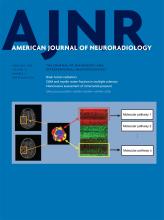Index by author
Johnson, M.H.
- Extracranial VascularYou have accessCarotid Artery Wall Imaging: Perspective and Guidelines from the ASNR Vessel Wall Imaging Study Group and Expert Consensus Recommendations of the American Society of NeuroradiologyL. Saba, C. Yuan, T.S. Hatsukami, N. Balu, Y. Qiao, J.K. DeMarco, T. Saam, A.R. Moody, D. Li, C.C. Matouk, M.H. Johnson, H.R. Jäger, M. Mossa-Basha, M.E. Kooi, Z. Fan, D. Saloner, M. Wintermark, D.J. Mikulis and B.A. Wasserman on behalf of the Vessel Wall Imaging Study Group of the American Society of NeuroradiologyAmerican Journal of Neuroradiology February 2018, 39 (2) E9-E31; DOI: https://doi.org/10.3174/ajnr.A5488
Jun-o'connell, A.H.
- Adult BrainOpen AccessLeukoaraiosis Attenuates Diagnostic Accuracy of Large-Vessel Occlusion ScalesY. Mayasi, R.P. Goddeau, M. Moonis, B. Silver, A.H. Jun-O'Connell, A.S. Puri and N. HenningerAmerican Journal of Neuroradiology February 2018, 39 (2) 317-322; DOI: https://doi.org/10.3174/ajnr.A5473
Jung, C.
- FELLOWS' JOURNAL CLUBNeurointerventionYou have accessFeasibility of Permanent Stenting with Solitaire FR as a Rescue Treatment for the Reperfusion of Acute Intracranial Artery OcclusionH.G. Woo, L. Sunwoo, C. Jung, B.J. Kim, M.-K. Han, H.-J. Bae, Y.J. Bae, B.S. Choi and J.H. KimAmerican Journal of Neuroradiology February 2018, 39 (2) 331-336; DOI: https://doi.org/10.3174/ajnr.A5477
From January 2011 through January 2016, among 2979 patients with acute ischemic stroke, the authors identified 27 patients who underwent permanent stent placement (13 patients with the Solitaire FR and 14 patients with other self-expanding stents). The postprocedural modified TICI grade and angiographic and clinical outcomes were assessed. Stent placement was successful in all cases. Modified TICI 2b=3 reperfusion was noted in 84.6% of the Solitaire group and in 78.6% of the other stent group. They conclude that permanent stent placement with the Solitaire FR compared with other self-expanding stents appears to be feasible and safe as a rescue tool for refractory intra-arterial therapy.
Jung, W.S.
- Adult BrainYou have accessDiffusion-Weighted Imaging of Brain Metastasis from Lung Cancer: Correlation of MRI Parameters with the Histologic Type and Gene Mutation StatusW.S. Jung, C.H. Park, C.-K. Hong, S.H. Suh and S.J. AhnAmerican Journal of Neuroradiology February 2018, 39 (2) 273-279; DOI: https://doi.org/10.3174/ajnr.A5516
Kabadi, S.J.
- Head and Neck ImagingYou have accessSemiautomated Middle Ear Volume Measurement as a Predictor of Postsurgical Outcomes for Congenital Aural AtresiaS.J. Kabadi, D.S. Ruhl, S. Mukherjee and B.W. KesserAmerican Journal of Neuroradiology February 2018, 39 (2) 355-361; DOI: https://doi.org/10.3174/ajnr.A5475
Kalpathy-cramer, J.
- Adult BrainOpen AccessRadiomics in Brain Tumor: Image Assessment, Quantitative Feature Descriptors, and Machine-Learning ApproachesM. Zhou, J. Scott, B. Chaudhury, L. Hall, D. Goldgof, K.W. Yeom, M. Iv, Y. Ou, J. Kalpathy-Cramer, S. Napel, R. Gillies, O. Gevaert and R. GatenbyAmerican Journal of Neuroradiology February 2018, 39 (2) 208-216; DOI: https://doi.org/10.3174/ajnr.A5391
Kamal, N.
- You have accessJohn Nash and the Organization of Stroke CareM. Goyal, A.T. Wilson, D. Mayank, N. Kamal, D.H. Robinson, D. Turkel-Parrella and J.A. HirschAmerican Journal of Neuroradiology February 2018, 39 (2) 217-218; DOI: https://doi.org/10.3174/ajnr.A5481
Kesser, B.W.
- Head and Neck ImagingYou have accessSemiautomated Middle Ear Volume Measurement as a Predictor of Postsurgical Outcomes for Congenital Aural AtresiaS.J. Kabadi, D.S. Ruhl, S. Mukherjee and B.W. KesserAmerican Journal of Neuroradiology February 2018, 39 (2) 355-361; DOI: https://doi.org/10.3174/ajnr.A5475
Khamis, A.M.
- Pediatric NeuroimagingYou have accessOptic Nerve Measurement on MRI in the Pediatric Population: Normative Values and CorrelationsC.E. Al-Haddad, M.G. Sebaaly, R.N. Tutunji, C.J. Mehanna, S.R. Saaybi, A.M. Khamis and R.G. HouraniAmerican Journal of Neuroradiology February 2018, 39 (2) 369-374; DOI: https://doi.org/10.3174/ajnr.A5456
Khan, N.
- EDITOR'S CHOICEAdult BrainOpen AccessFeasibility of Brain Atrophy Measurement in Clinical Routine without Prior Standardization of the MRI Protocol: Results from MS-MRIUS, a Longitudinal Observational, Multicenter Real-World Outcome Study in Patients with Relapsing-Remitting MSR. Zivadinov, N. Bergsland, J.R. Korn, M.G. Dwyer, N. Khan, J. Medin, J.C. Price, B. Weinstock-Guttman and D. Silva on behalf of the MS-MRIUS Study GroupAmerican Journal of Neuroradiology February 2018, 39 (2) 289-295; DOI: https://doi.org/10.3174/ajnr.A5442
Brain atrophy outcomes of 590 patients were analyzed by the percentage brain volume change measured by structural image evaluation with normalization of atrophy on 2D-T1WI and 3D-T1WI and the percentage lateral ventricle volume change, measured by VIENA on 2D-T1WI and 3D-T1WI and NeuroSTREAM on T2-FLAIR examinations. The median annualized percentage brain volume change was -0.31% on 2D-T1WI and -0.38% on 3D-T1WI. The median annualized percentage lateral ventricle volume change was 0.95% on 2D-T1WI, 1.47% on 3D-T1WI, and 0.90% on T2-FLAIR. The authors conclude that brain atrophy was more readily assessed by estimating the percentage lateral ventricle volume change on T2-FLAIR compared with the percentage brain volume change or percentage lateral ventricle volume change using 2D- or 3D-T1WI.








